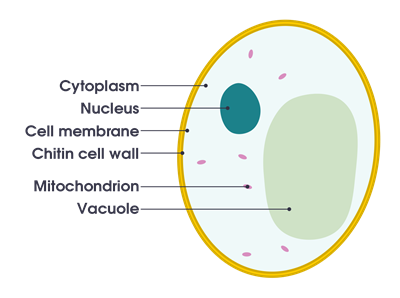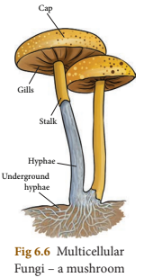
PUMPA - SMART LEARNING
எங்கள் ஆசிரியர்களுடன் 1-ஆன்-1 ஆலோசனை நேரத்தைப் பெறுங்கள். டாப்பர் ஆவதற்கு நாங்கள் பயிற்சி அளிப்போம்
Book Free DemoFungi live either on the dead organic matter or on the body of humans and animals. They come under the kingdom 'Fungi'.
Fungi are either saprophytic heterotrophs or parasites. While heterotrophs live and derive their food from the dead organic matter, parasites live and derive their nutrition from the living cells of plants or animals.
Fungi are either saprophytic heterotrophs or parasites. While heterotrophs live and derive their food from the dead organic matter, parasites live and derive their nutrition from the living cells of plants or animals.
- Fungi destroy the remains of plants and animals and contribute to the formation of fertile soil.
- Valuable medicines are obtained from some mushrooms.
- Edible mushrooms are eaten.
- Fungi are unicellular (Yeast) and multicellular (Penicillium) organisms. These organisms belong to eukaryotes because their cells have a nucleus. They grow in the dead or decomposing organic materials.
- Unlike plant cells, fungi do not have chlorophyll. Many fungi display bright colours such as red, brown, green or black due to the cellular pigments.
Mushrooms, a multicellular fungi, occupy a special position in the system of the organic world. They are neither plants nor animals but have some similarities with the representatives of both kingdoms.
Important!
Do you know:
Human beings and fungi share some similarities!
Fungi and human beings are heterotropic in nature, both do aerobic respiration and both reserve food material in the form of glycogen.
Unicellular fungi
- Unicellular or single-celled fungi are grouped under the common name Yeast.
- Yeast grows in materials that contain sugar.
- Yeast cells are ovoid in shape, having a well-defined nucleus within a protective cell wall. The cytoplasm has vacuoles (empty spaces) and glycogen in addition to cellular organelles.
- Yeast is extensively used in the fermentation process.
- Yeast can also exist in an oxygen-less environment or anaerobic conditions.
- Yeasts reproduce through budding.

About 500 species of yeasts are known.
Man has been using yeast for making bread for a long time.
Yeast grows very quickly and show extremely high rate metabolism. At the same time, they significantly change the chemical composition of the environment. The most well-known process they carry out is alcoholic fermentation. Yeast feeds on sugar, which is converted into alcohol. This releases carbon dioxide, which helps to raise the dough, making it light and porous.
Some yeasts are used in brewing, winemaking and as a protein feed in animal husbandry.
Multicellular fungi
In higher fungi, the cells may contain one or more nuclei. Higher fungi can form fruiting bodies. The typical fruiting body of such a fungus consists of a cap and a leg. Mushrooms are such fruiting bodies.

- Under the cap-like structure, there are spongy slits called as 'gills'. Gills contain spores which are similar to seeds.
- The cap is supported by a stalk which contains 'hyphae'. Hyphae help to transport nutrients from the soil to the different parts of the mushroom. The hyphae extend as mycelium under the ground and this mycelium help the mushroom to suck the nutrients from the material over which it grows. The walls that encompass the hyphae is made up of chitin and cellulose.
Mushrooms are necessary elements in the manufacture of bread, cheese, winemaking, etc.
Some mushrooms can cause great harm. Some of them may cause diseases to plants, animals and humans. Mushrooms spoil food. Some mushrooms produce poisonous substances.
The kingdom of fungi
The kingdom of fungi is one of the largest and most prosperous groups of organisms. At present, about 100 thousand species of fungi are known.
Examples:
| Saprophytic fungi | Parasitic fungi |
| Rhizopus | Puccinia |
| Penicillium | Albugo |
| Agaricus | Ustilago |
| Aspergillus | Mycorrhiza (a symbiotic fungi) |
Important!
Do you know:
What is the study of fungi called?
Mycology!
Reference:
Image credit:
Yeast: Free image from Wikipedia; https://en.wikipedia.org/wiki/Yeast#/media/File:Simple_diagram_of_yeast_cell_(en).svg